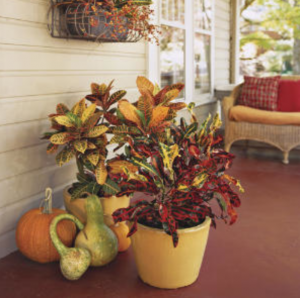Our florists at Belle Fiori often receive questions about which plants we love to display during each season. Recommending options for fall is always one of my favorites, as I really enjoy the earthy tones autumn has to offer.
One of my favorite types of fall-toned foliage is the croton. Displaying variations of red, yellow, and orange leaves, crotons are a great way to add some color to your home for the season. Typically hearty houseplants, these chameleons make excellent decorations for an indoor display or porch arrangement when paired with pumpkins or gourds. (Just make sure to bring them inside before it gets too chilly!)
Check out a little background information and a few care tips on crotons…
Dazzling Foliage
By: Steve Bender
For a croton, subtlety is not a virtue. The gaudiest foliage plant in the world, it’s a Carmen Miranda with leaves and commands the garden’s limelight through sheer pomp and spectacle. Although it originates in a land without autumn, its extravagant costume of yellow, orange, and red exhibits the season’s signature colors.
Native to Indonesia and Malaysia, the croton (Codiaeum variegatum) is standard fare in Tropical South gardens, where it can grow into an evergreen shrub 6 feet tall and wide or larger. Elsewhere, it makes a phenomenal potted plant, either outdoors from spring to fall on a porch, deck, or patio or indoors year-round as a houseplant.
The croton offers a dizzying array of leaf colors, shapes, and sizes. The most common variety is calledpictum. Its magnolia-shaped leaves emerge yellow and green and then turn salmon, orange, and red as they age. Other types add colors of pink, purple, bronze, and nearly black to the mix with leaves that are oaklike, finger-like, spider-like, twisted, puckered, or spiraled.
Growing Tips
Crotons, whether grown indoors or outdoors, prefer bright light. They do fine in light shade, but sun really brings out the colors. Give them fertile, moist, well-drained soil. Feed them according to label directions with a slow-release granular fertilizer that works for several months. If your plants become sparse at the bottom, cut them back from the top to spur new growth. Keep the milky sap off of your skin, though, as it can be irritating. Don’t expose these plants to freezing weather unless you’re a really spiteful person.
Spider mites are the bane of crotons grown indoors. Look for tiny webs strung between the leaves and stems or tiny dots moving on the undersides of the leaves. Control mites by thoroughly spraying the leaves (especially the undersides) with soapy water or horticultural oil. Regular misting to humidify the air around the foliage also deters the little fiends.

